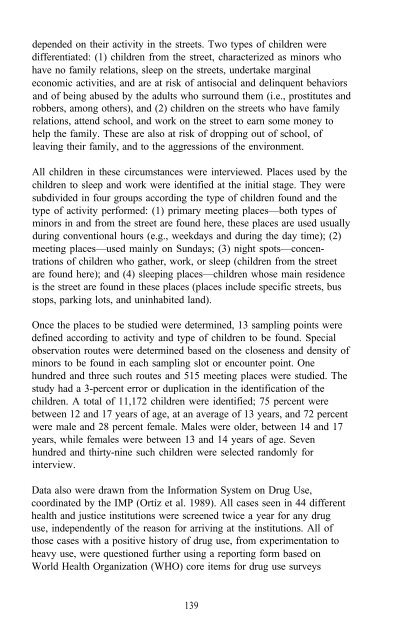Epidemiology of Inhalant Abuse - Archives - National Institute on ...
Epidemiology of Inhalant Abuse - Archives - National Institute on ...
Epidemiology of Inhalant Abuse - Archives - National Institute on ...
You also want an ePaper? Increase the reach of your titles
YUMPU automatically turns print PDFs into web optimized ePapers that Google loves.
depended <strong>on</strong> their activity in the streets. Two types <str<strong>on</strong>g>of</str<strong>on</strong>g> children were<br />
differentiated: (1) children from the street, characterized as minors who<br />
have no family relati<strong>on</strong>s, sleep <strong>on</strong> the streets, undertake marginal<br />
ec<strong>on</strong>omic activities, and are at risk <str<strong>on</strong>g>of</str<strong>on</strong>g> antisocial and delinquent behaviors<br />
and <str<strong>on</strong>g>of</str<strong>on</strong>g> being abused by the adults who surround them (i.e., prostitutes and<br />
robbers, am<strong>on</strong>g others), and (2) children <strong>on</strong> the streets who have family<br />
relati<strong>on</strong>s, attend school, and work <strong>on</strong> the street to earn some m<strong>on</strong>ey to<br />
help the family. These are also at risk <str<strong>on</strong>g>of</str<strong>on</strong>g> dropping out <str<strong>on</strong>g>of</str<strong>on</strong>g> school, <str<strong>on</strong>g>of</str<strong>on</strong>g><br />
leaving their family, and to the aggressi<strong>on</strong>s <str<strong>on</strong>g>of</str<strong>on</strong>g> the envir<strong>on</strong>ment.<br />
All children in these circumstances were interviewed. Places used by the<br />
children to sleep and work were identified at the initial stage. They were<br />
subdivided in four groups according the type <str<strong>on</strong>g>of</str<strong>on</strong>g> children found and the<br />
type <str<strong>on</strong>g>of</str<strong>on</strong>g> activity performed: (1) primary meeting places—both types <str<strong>on</strong>g>of</str<strong>on</strong>g><br />
minors in and from the street are found here, these places are used usually<br />
during c<strong>on</strong>venti<strong>on</strong>al hours (e.g., weekdays and during the day time); (2)<br />
meeting places—used mainly <strong>on</strong> Sundays; (3) night spots—c<strong>on</strong>centrati<strong>on</strong>s<br />
<str<strong>on</strong>g>of</str<strong>on</strong>g> children who gather, work, or sleep (children from the street<br />
are found here); and (4) sleeping places—children whose main residence<br />
is the street are found in these places (places include specific streets, bus<br />
stops, parking lots, and uninhabited land).<br />
Once the places to be studied were determined, 13 sampling points were<br />
defined according to activity and type <str<strong>on</strong>g>of</str<strong>on</strong>g> children to be found. Special<br />
observati<strong>on</strong> routes were determined based <strong>on</strong> the closeness and density <str<strong>on</strong>g>of</str<strong>on</strong>g><br />
minors to be found in each sampling slot or encounter point. One<br />
hundred and three such routes and 515 meeting places were studied. The<br />
study had a 3-percent error or duplicati<strong>on</strong> in the identificati<strong>on</strong> <str<strong>on</strong>g>of</str<strong>on</strong>g> the<br />
children. A total <str<strong>on</strong>g>of</str<strong>on</strong>g> 11,172 children were identified; 75 percent were<br />
between 12 and 17 years <str<strong>on</strong>g>of</str<strong>on</strong>g> age, at an average <str<strong>on</strong>g>of</str<strong>on</strong>g> 13 years, and 72 percent<br />
were male and 28 percent female. Males were older, between 14 and 17<br />
years, while females were between 13 and 14 years <str<strong>on</strong>g>of</str<strong>on</strong>g> age. Seven<br />
hundred and thirty-nine such children were selected randomly for<br />
interview.<br />
Data also were drawn from the Informati<strong>on</strong> System <strong>on</strong> Drug Use,<br />
coordinated by the IMP (Ortíz et al. 1989). All cases seen in 44 different<br />
health and justice instituti<strong>on</strong>s were screened twice a year for any drug<br />
use, independently <str<strong>on</strong>g>of</str<strong>on</strong>g> the reas<strong>on</strong> for arriving at the instituti<strong>on</strong>s. All <str<strong>on</strong>g>of</str<strong>on</strong>g><br />
those cases with a positive history <str<strong>on</strong>g>of</str<strong>on</strong>g> drug use, from experimentati<strong>on</strong> to<br />
heavy use, were questi<strong>on</strong>ed further using a reporting form based <strong>on</strong><br />
World Health Organizati<strong>on</strong> (WHO) core items for drug use surveys<br />
139
















